Last weekend was a busy wildlife weekend for me. Just before zooming down to the Rockport Hummer/Bird Festival, I visited another bird paradise much closer to home. I almost didn’t post about it, simply because it was difficult to capture pictures of the birds without a zoom lens, and due to circumstances mentioned below, the migrant birds were relatively few. But this wildlife habitat, the lands and waters of Hornsby Bend, is so remarkable that I wanted to draw attention to it, especially for anyone in central Texas or visitors to the area. Birding binoculars are highly recommended!
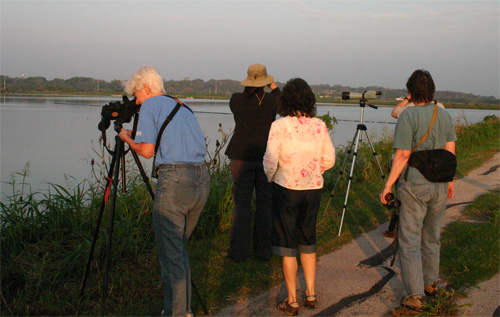 Hornsby Bend is an area along a “bend” of the Colorado River, southeast of Austin, Texas, near the airport. Once home to dense forests and thickets, a man named Reuben Hornsby settled there in 1832, clearing the land for agricultural uses. Today it is home to the Hornsby Bend Biosolids Management Plant, which deals with — yes, that’s right — our city’s poop. But this is a particularly good thing, because the Hornsby Bend plant combines the treated solid wastes with residential yard trimmings (picked up curbside) to make Dillo Dirt — a nutrient-rich compost. The plant also houses the AWU Center for Environmental Research, which studies urban ecology and sustainability.
Hornsby Bend is an area along a “bend” of the Colorado River, southeast of Austin, Texas, near the airport. Once home to dense forests and thickets, a man named Reuben Hornsby settled there in 1832, clearing the land for agricultural uses. Today it is home to the Hornsby Bend Biosolids Management Plant, which deals with — yes, that’s right — our city’s poop. But this is a particularly good thing, because the Hornsby Bend plant combines the treated solid wastes with residential yard trimmings (picked up curbside) to make Dillo Dirt — a nutrient-rich compost. The plant also houses the AWU Center for Environmental Research, which studies urban ecology and sustainability.
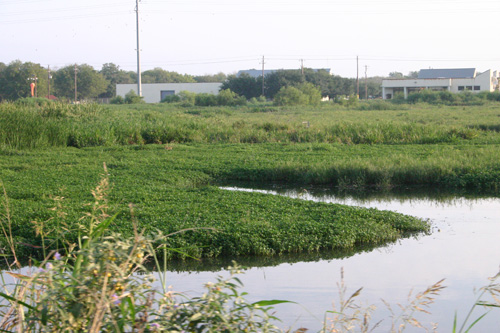 But Hornsby Bend is so much more — 1,200 acres of marshes, woodlands, pastures, and riparian (river) areas. Because of the incredible biodiversity along the food chain and its multiple habitats, it has become known nationally as one of the best birdwatching sites in Texas, especially during times of migration. More than 360 species of birds have been sighted at Hornsby Bend. Migratory shorebirds, wading birds, and landbirds, some from the Arctic or from the southern tip of South America, stop at the ponds of Hornsby Bend as they travel to and from their winter habitats.
But Hornsby Bend is so much more — 1,200 acres of marshes, woodlands, pastures, and riparian (river) areas. Because of the incredible biodiversity along the food chain and its multiple habitats, it has become known nationally as one of the best birdwatching sites in Texas, especially during times of migration. More than 360 species of birds have been sighted at Hornsby Bend. Migratory shorebirds, wading birds, and landbirds, some from the Arctic or from the southern tip of South America, stop at the ponds of Hornsby Bend as they travel to and from their winter habitats.
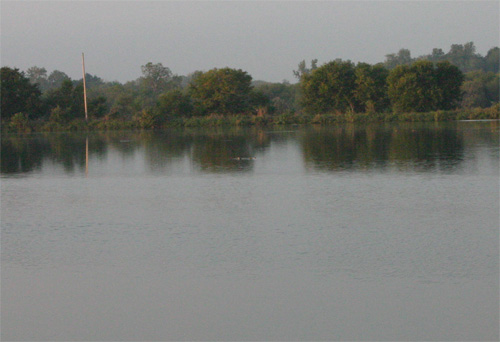
Though Hornsby Bend is best known for its birds, the native plants along the shores of the ponds and river provide excellent butterfly and dragonfly viewing as well.
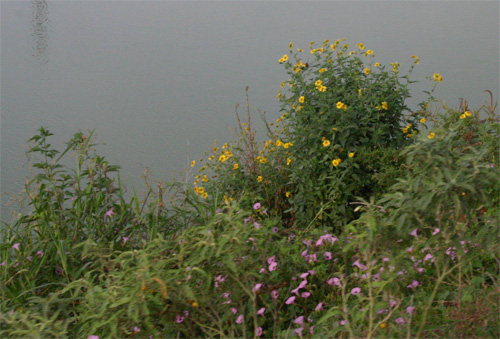
Members of Travis Audubon and other organizations survey the birds and other wildlife frequently year-round, but the peak months to view migrating birds are August and September, with wintering birds arriving in October through December. March and April are the peak months for spring migration.
Due to recent rains in Central Texas, the normal shorelines of the lagoons were underwater, so during my visit to Hornsby for Habitat Steward Training, there were very few migrating shorebirds, despite it being a peak month for migration through the area. Audubon viewers did note 57 different species that day, however, including various grebes, kingfishers, vireos, hawks, egrets, swallows, orioles, and many, many more. But with the cold front incoming this week, the birders at Hornsby said that many other species would be arriving, and they expected local birdwatchers to flock to the ponds (pun intended) for species viewing. Our group did see many barn swallows enjoying the insects near the ponds, and several duck species.
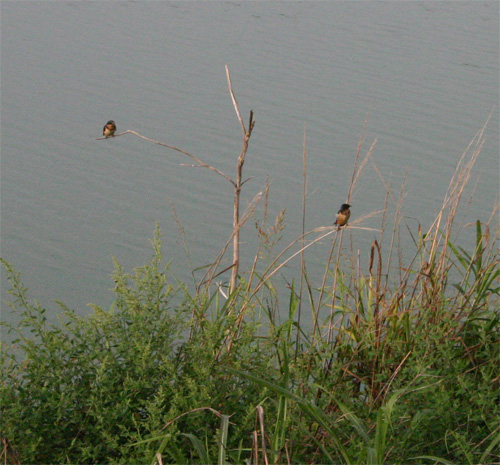 Near the wet grounds by the compost, many least sandpipers and other species scooted about for insects.
Near the wet grounds by the compost, many least sandpipers and other species scooted about for insects.
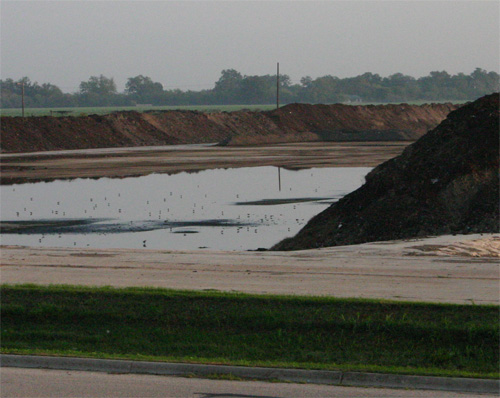 And humans studied them from afar.
And humans studied them from afar.
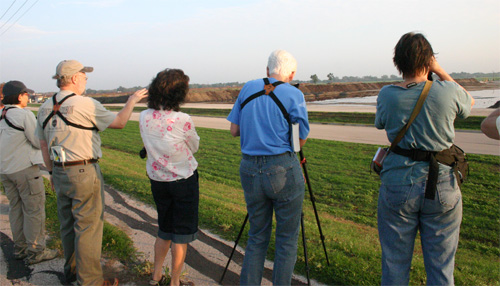 The wooded areas along the river provided opportunities to see tree-perching birds. A quiet walk along the paths allowed us to listen to the beautiful songs of many a bird, including the white-eyed vireo.
The wooded areas along the river provided opportunities to see tree-perching birds. A quiet walk along the paths allowed us to listen to the beautiful songs of many a bird, including the white-eyed vireo.
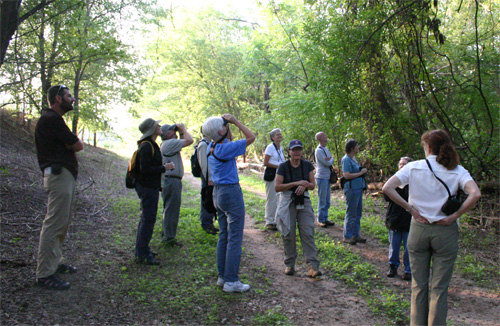 Another treatment area, these long greenhouses will also provide winter shelter to area birds. A red-shouldered hawk reportedly has hunted in there, in fact.
Another treatment area, these long greenhouses will also provide winter shelter to area birds. A red-shouldered hawk reportedly has hunted in there, in fact.
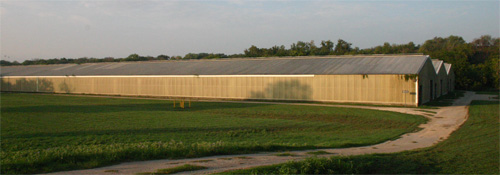 Near the main building at Hornsby Bend, viewers can enjoy butterflies, hummingbirds, and other wildlife visiting the demonstration habitat. Hummingbirds are particularly fond of the thriving Tropical Sage (Salvia coccinea) among the many plants in the gardens.
Near the main building at Hornsby Bend, viewers can enjoy butterflies, hummingbirds, and other wildlife visiting the demonstration habitat. Hummingbirds are particularly fond of the thriving Tropical Sage (Salvia coccinea) among the many plants in the gardens.
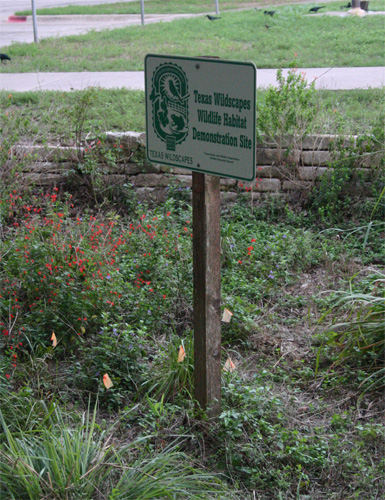 And there are purple martins, too, though they are absent in September.
And there are purple martins, too, though they are absent in September.
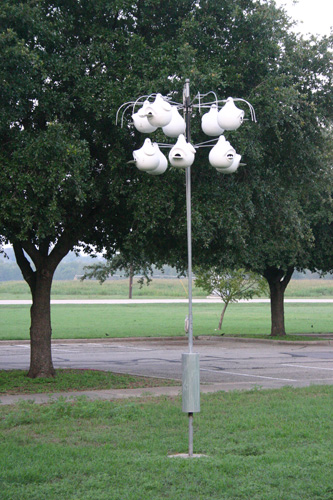
A few words about Dillo Dirt. The Dillo Dirt program was created in 1989, the first such program in the state of Texas, and one of the oldest in the nation. The natural process of creating this compost produces temperatures up to 170 degrees Fahrenheit, which kills human and plant pathogens. The compost is further cured and screened before becoming the final Dillo Dirt product. Rather than wastes filling a landfill or being dumped into rivers, this incredibly beneficial compost returns organic material to the soils of Austin yards, pastures, golf courses, and other landscapes.
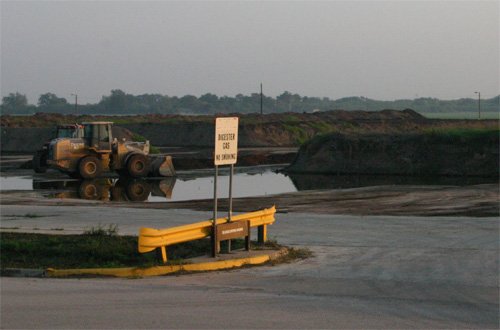 Back at the main building, the Habitat Steward Trainees listened to three speakers. The knowledge I gained this day was tremendous, from the history of the soil in the Austin area to the how’s and whys of organic matter, and from butterflies of Central Texas to urban wildlife, such as coyotes and raccoons. A great day, and a great place to visit.
Back at the main building, the Habitat Steward Trainees listened to three speakers. The knowledge I gained this day was tremendous, from the history of the soil in the Austin area to the how’s and whys of organic matter, and from butterflies of Central Texas to urban wildlife, such as coyotes and raccoons. A great day, and a great place to visit.
Nice view. The birds are looking so lonely sitting and silent. Congrats on your blog for blotanical awards nominations, i think yours been in 2 or 3 categories i guess. best of luck!!
Thank you so much — I wish I’d had more bird pictures for a bird post, but alas, rain and camera conspired against me that day. Thank you about the nominations — I am very honored to be included!
You’ve been sharing some very interesting things in your latest posts. Thank you. It’s inspiring to hear about. Congrats on your nominations.